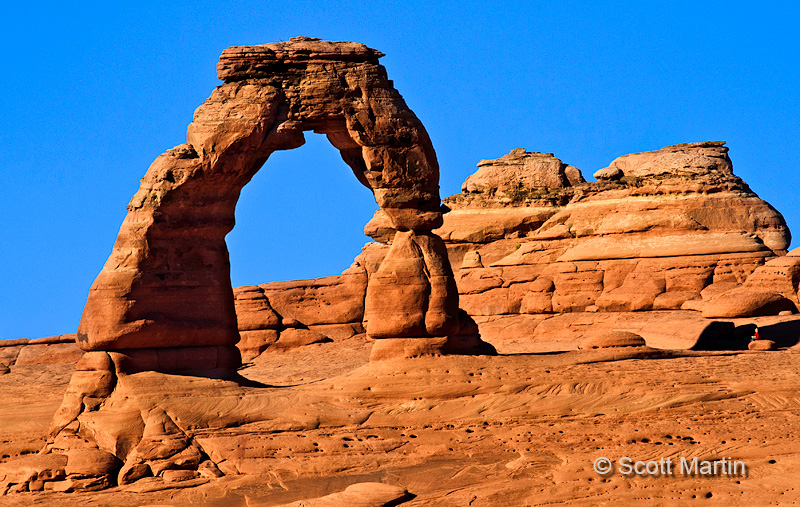
by Scott Martin Photography | Apr 9, 2012 | Blog, Landscapes, Naturescapes, Travel
Arches National Park contains an incredible display of some of the most interesting geologic formations on the planet and as the name implies, many of them are aches. In fact, there are over two thousand natural stone arches in the park. Probably the most famous arch in the park is Delicate arch, which requires a little hiking to get to, however spending a sunset at the arch is certainly one of the best sunsets you will ever see.
Delicate Arch lies on the edge of a precipice about one thousand feet above a salt valley and can be viewed from either side of the valley, although from the opposite side of the valley you are probably a mile or so from the arch. Deb and I observed the arch from both sides of the valley, which made for an enjoyable afternoon of hiking, although carrying thirty pounds of camera gear felt like three hundred pounds by the time we were finished.
We first hiked the Delicate Arch Viewpoint trail, which is an easy 1.8 mile loop that gains about three hundred feet in elevation from the trailhead. The view across the salt valley to the arch is impressive however you will need a long lens to photograph the arch from this vantage point. This first shot was taken from the natural amphitheatre across the valley from the arch with a 400mm lens. The little guy in a bright red shirt sitting alone on a boulder looking at the arch makes this shot.

The hike to the base of the arch is a bit more arduous, and climbs about 500 feet over a trail that creates a round trip of just over three miles. It’s an interesting trail in that you don’t see the arch until the last few feet of the hike, but what an incredible sight when you come out from walking along a sandstone wall and catch that first view of the arch. About five hundred feet before reaching the top of the trail, your can see Framers Arch in the sandstone wall that blocks the view of Delicate Arch. You have to climb up the wall about twenty feet, but viewing Delicate Arch through Framers Arch makes for a good photograph.
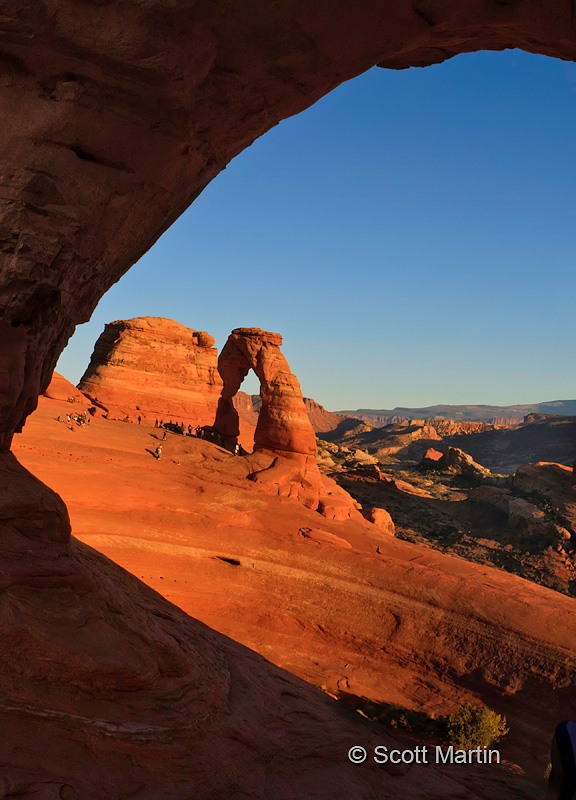
Delicate Arch overlooks a salt valley with the La Sal mountain range in the back ground.
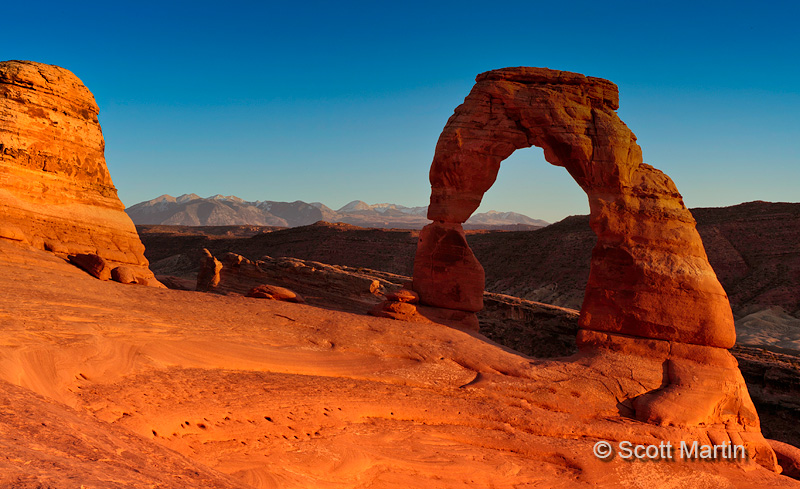
As the sun goes down over the horizon the natural red rocks take on an amazing colour.
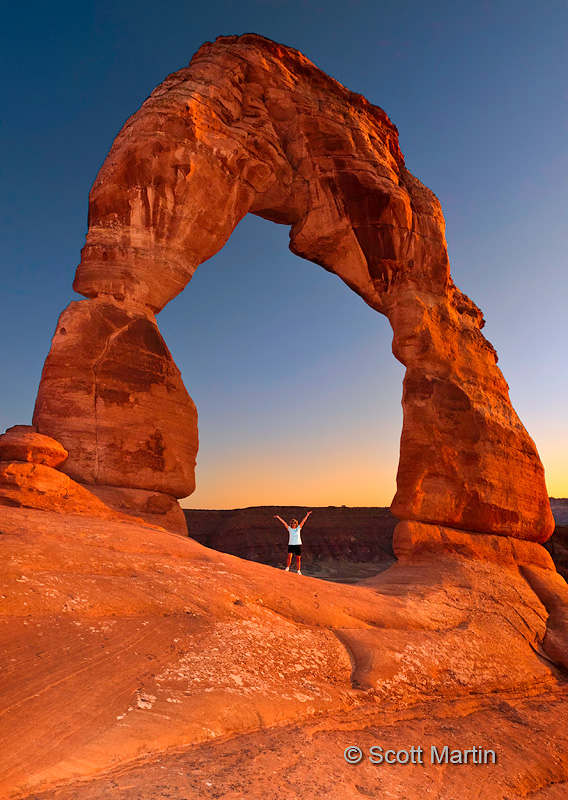
Sunset at Delicate Arch.
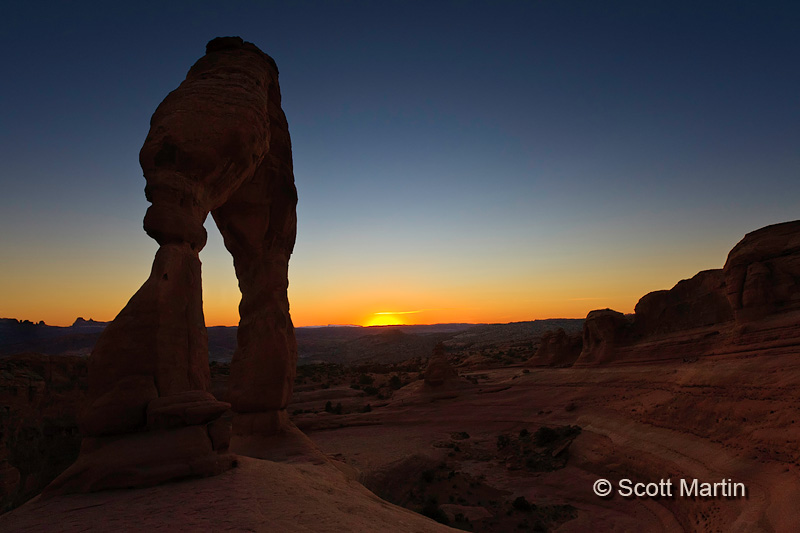
.
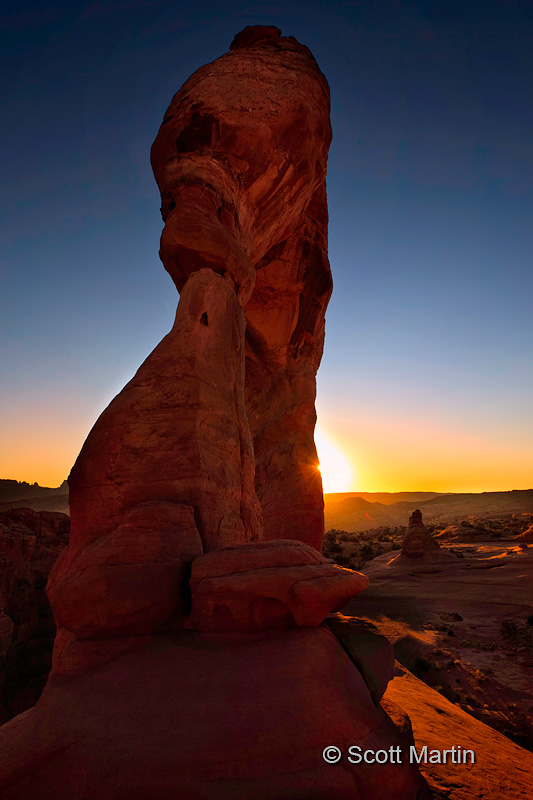
.
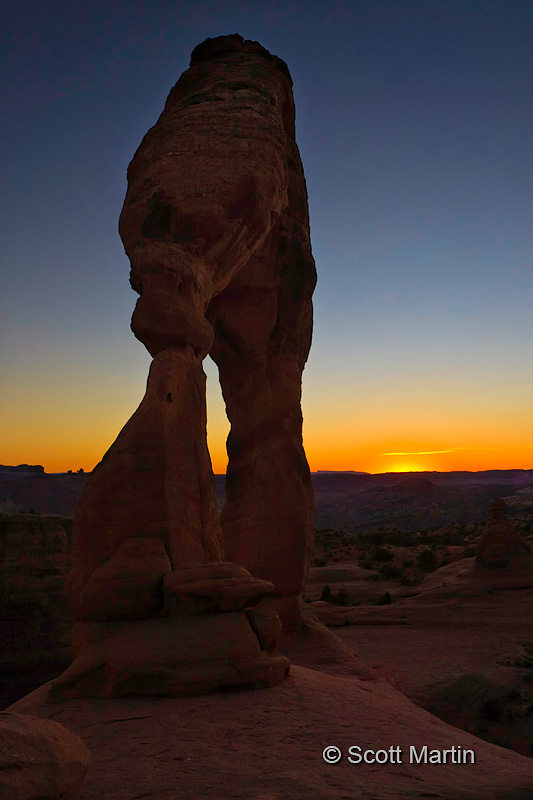
Seeing the Delicate Arch was one of the many highlights of our trip to the canyon lands area of the States and I trust these images encourage you to make the trip!
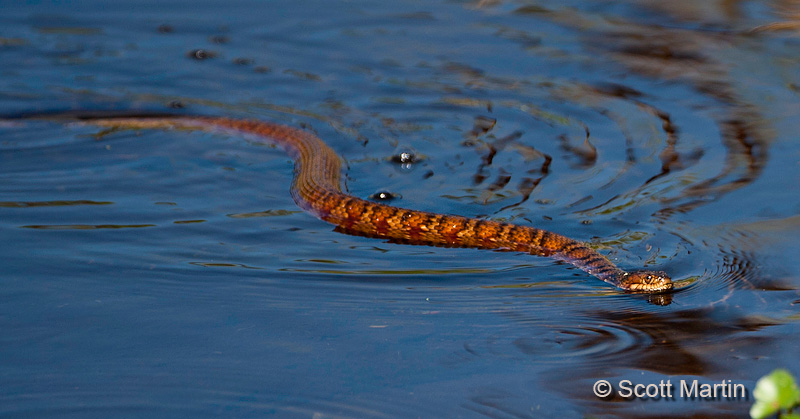
by Scott Martin Photography | Apr 8, 2012 | Blog, Travel, Wildlife
Orlando Wetland Park is located about forty-five minutes east of Orlando in Christmas, Florida. It’s a wonderful spot to walk and observe the diverse fauna and flora typical of Florida wetland habitat. While Deb and I wandered around the wetlands, quite lost in the vast expanse of the park, we met Josh and his family, who were serious herpetologists. They taught us a whole new way to observe wetlands, concentrating on the snakes and reptiles of the area as opposed to the birds we normally focus on. There is a whole new world out there, one that we will pay more attention to next time in the wetlands and I probably won’t wander as close to the water’s edge to get that low angle on a shore bird without also looking for fangs and rattles.
Florida Banded Water Snake

Pygmy Rattlesnake, a small rattler that is rather reclusive however we were told not to confuse its small size with its ability to really cause some grief if it sunk its fangs into your leg. Apparently, although rarely fatal in adults, a bite would cause a couple of days of severe pain regardless of treatment.
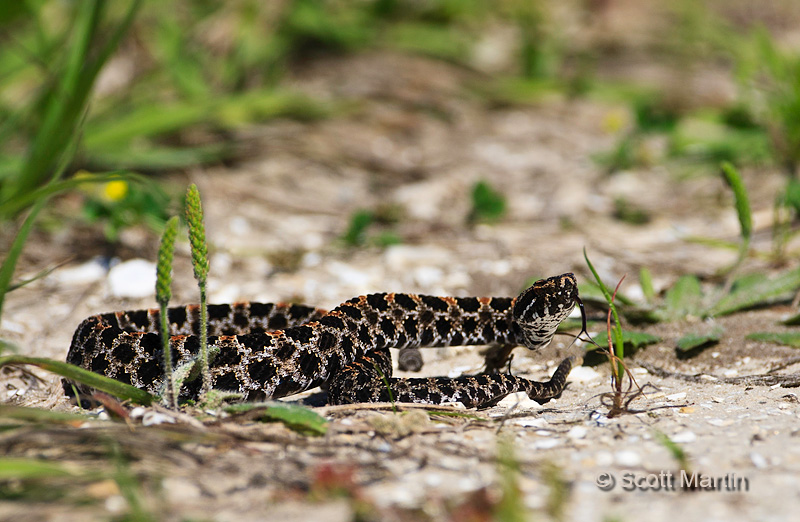
.
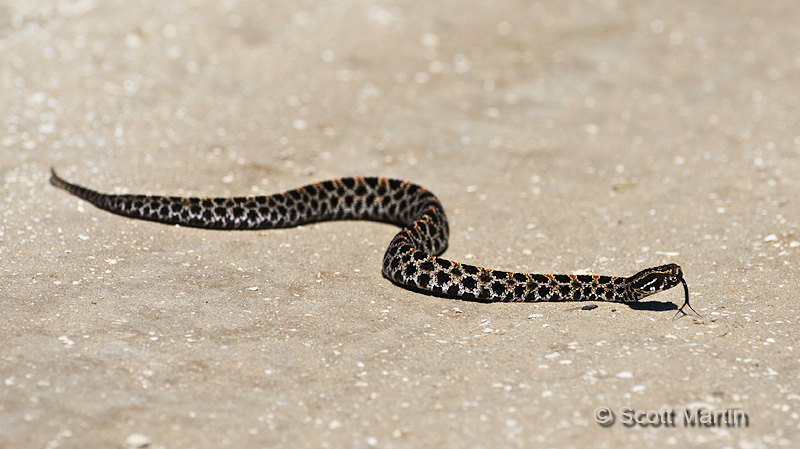
The Water Moccasin is a pit viper that is also found in Florida. Much larger than the Pygmy Rattler and although rarely aggressive towards humans does posses a potentially fatal bite. The Water Moccasin is the world’s only semiaquatic viper. The following image was taken at the Viera Wetlands, about thirty miles south-east of the Orlando Wetland Park.
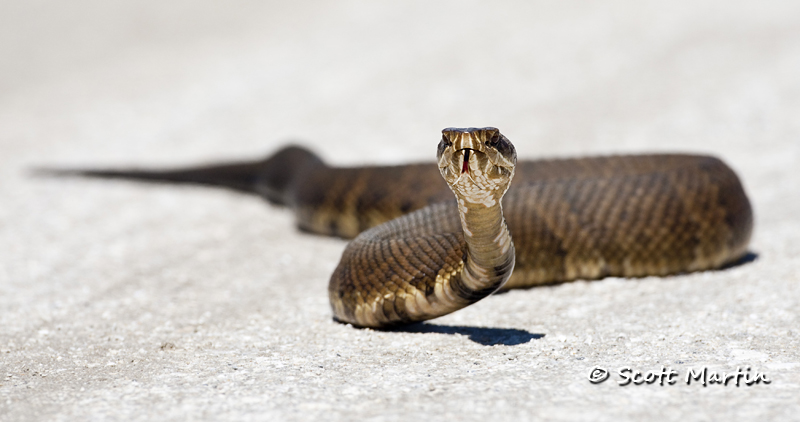
The Orlando Wetlands Park is also known for the large Garpike that inhabit some of its ponds. The gar has a body shape not unlike our Northern Pike, however their broad, teeth lined mouths give the Garpike a very distinctive look.
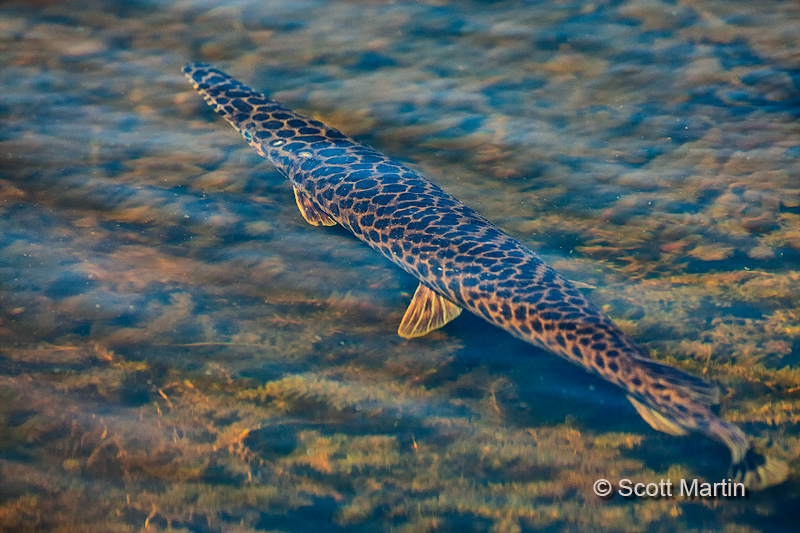
It’s almost impossible not to see alligators while walking around in Florida wetlands, however it is unusual to see new-born alligators as we did this year. We counted eight little gators, that Josh explained to us were probably only a day old and enjoyed watching them swimming around under the watchful eye of their mother who was lurking close by in the reeds. The young alligators were about ten inches long and almost cute….well maybe that’s an exaggeration.
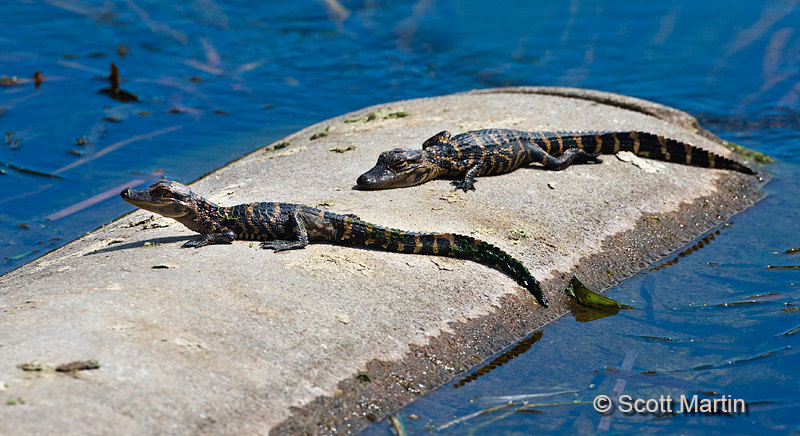
Someday they will look like this.
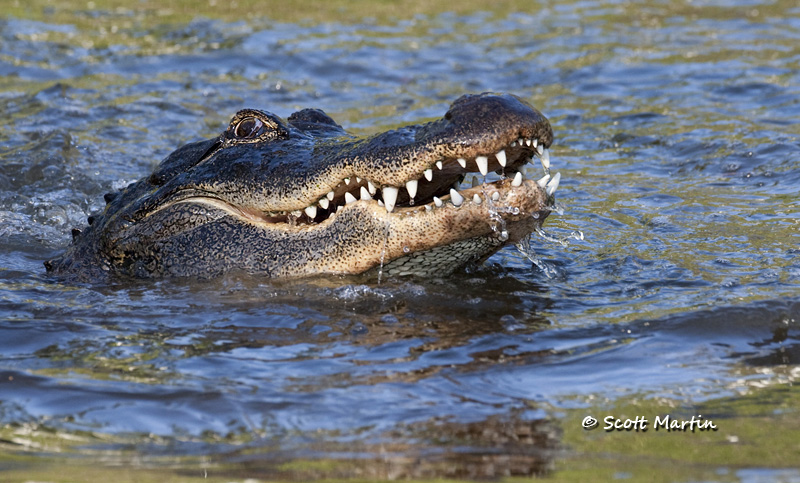
In keeping with the wildlife theme of this post, here are a couple of shots taken in Algonquin Park just before we headed to Florida for March break. This Red Fox was very friendly, infact as soon as I squatted down to get a low angle for these shots the fox came right up to the end of my lens, presumably looking for a handout.
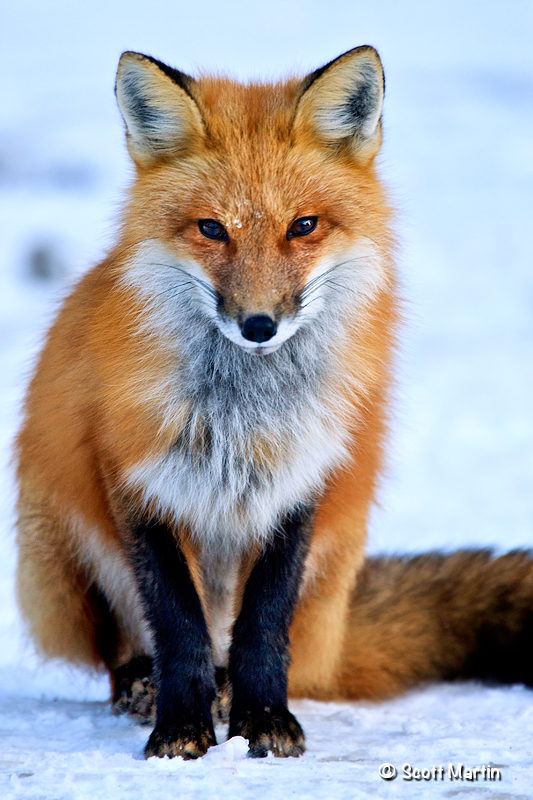
.
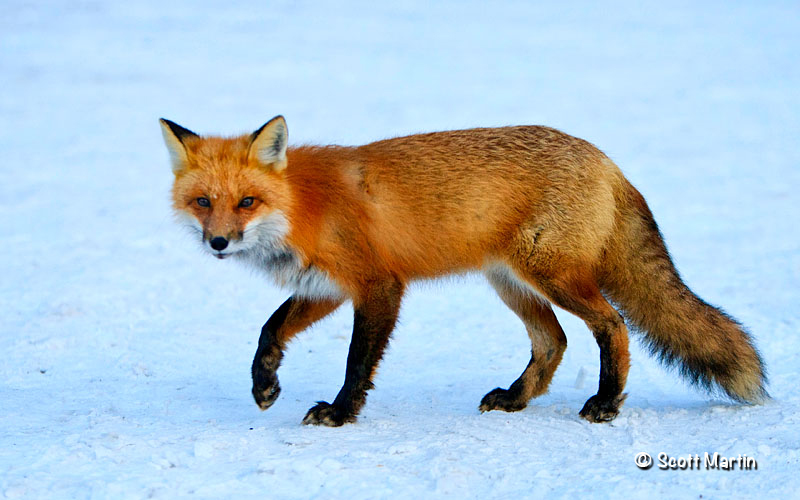
Other sample of wildlife can be seen in the gallery
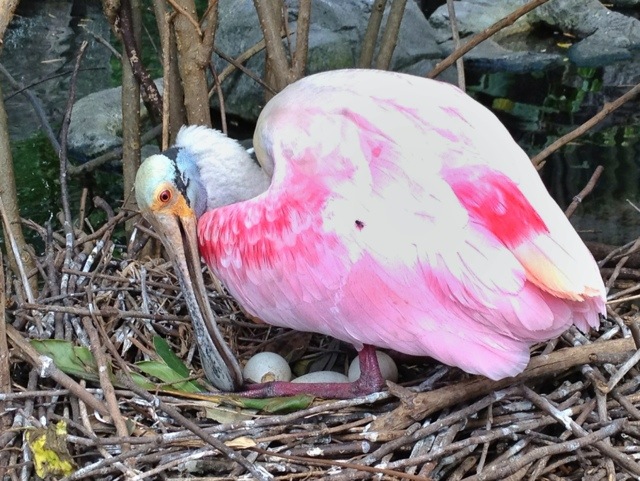
by Scott Martin Photography | Mar 16, 2012 | Birds, Blog, Shore Birds & Waterfowl, Travel
The Roseate Spoonbill has always been a favourite of mine and every trip to Florida we try to get a few shots of them. This year provided an interesting opportunity to photograph a Spoonbill with an iPhone. So please excuse the blown highlights in this image, but exposure control on the iPhone is not as user friendly as it should be 🙂
The Roseate Spoonbill is a bird who’s beak is ideally designed to allow it to eat effectively. The Spoonbill eats by waving the broad spoon shaped end of its beak in shallow water, disturbing the water and silt beneath it. It has very sensitive nerve cells that cause the beak to reflexly snap shut when prey is detected. The vibrant pink colours the Spoonbill takes on as it matures (they are born white) is a result of carotenoid pigments in algae which are consumed by crustaceans and then in turn eaten by the spoonbills. The Spoonbill’s nostrils are located at the base of their beaks so they are able to breath while the spoon end of the bill is submerged while foraging.
The following image was shot with the iPhone 4S and processed with the Snapseed app designed by NIK Software.

28.335975-81.53299
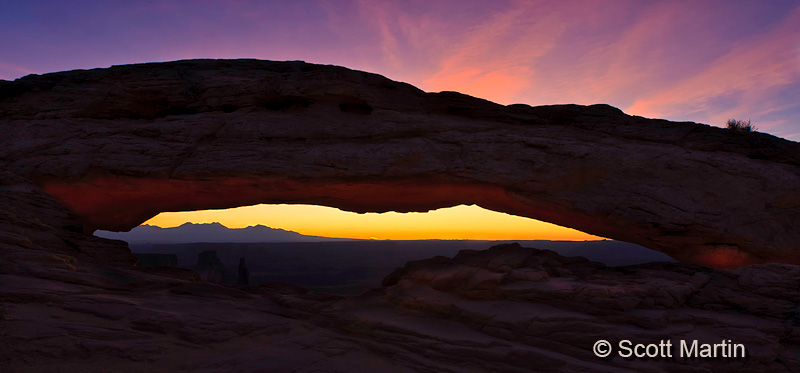
by Scott Martin Photography | Mar 2, 2012 | Blog, Landscapes, Naturescapes, Travel
Photographing the Mesa Arch at sunrise is something every serious landscape photographer wants to do before hanging up the camera gear. In order to be there on time requires a bit of effort however that effort is richly rewarded as you watch the sun break over the horizon and under the arch, illuminating the La Sal mountain range some thirty-five miles away and the Colorado River Basin two thousand feet below. It was 34°F when Deb & I left our hotel in Moab Utah around 4:30 a.m. for the forty mile drive to the Mesa Arch trail head which is in the Island In The Sky region of Canyonlands National Park. From the trailhead we hiked the rather short trail (half of a mile) in the dark but didn’t require flashlights all of the way as the moon light was wonderful that morning. Once we claimed a spot for the tripod and set things up we had about 45 minutes before sunrise during which we got a chance to chat with the twenty or so others who arrived before the sun came up. Make sure to arrive early if you want a good spot!
The exposures for the images posted today range from less than a second to more than thirty seconds and were all taken with a Canon 1D MK III and 16-35/2.8 or 24-105/4 lenses. Most were taken with Lee and Singh-Ray 4×6 ND grad filters.
Before the sunrise.

Sunrise….at one of the prettiest places on earth to watch the sun come up. When photographing sunrises, always use a small aperture of f/18 or smaller which creates the starburst look of the sun. This is true for any bright light source in your image (street lights, stars, Christmas lights, candles etc). If you want the starburst effect, use the smallest aperture possible. This means using a tripod because of the longer exposures required but it is worth the effort and creates excellent results.
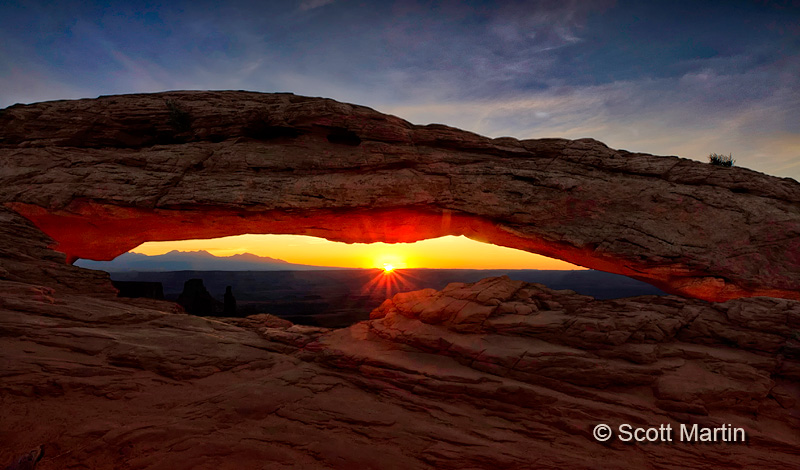
.
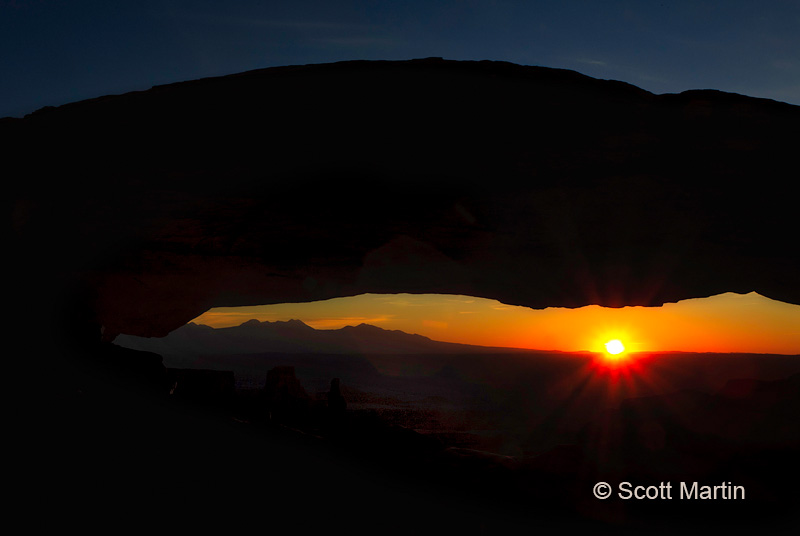
After the sunrise we had some time to explore around the arch and photograph it from many different angles. The following are a few of our favourites as well as some general shots to give you a sense of the area.
The underside of the arch literally starts to glow a few minutes before sunrise and is amazing to watch. In looking at the arch, my theory is that the glowing phenomenon is created by the early light reflecting off the cliff face upwards onto the underside of the arch which overhangs the 1800 foot precipice. The oxide rich sandstone makes the warm early light take on the even richer red & orange shades seen in the images. I think this next shot illustrates the point.
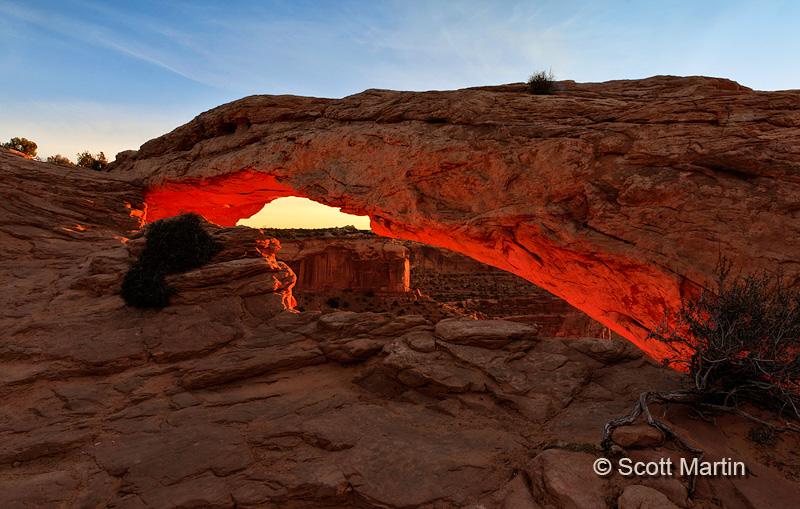
From the other direction.

A group shot!
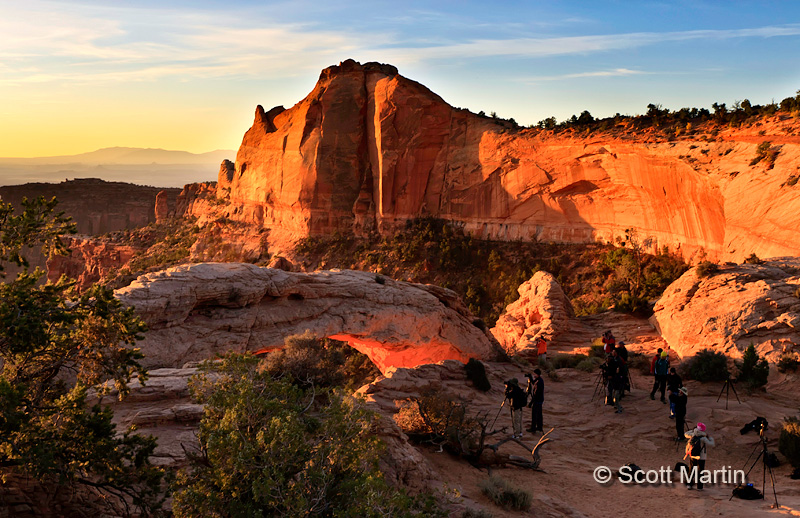
The arch from above (you can see a person at the top of the arch for perspective).
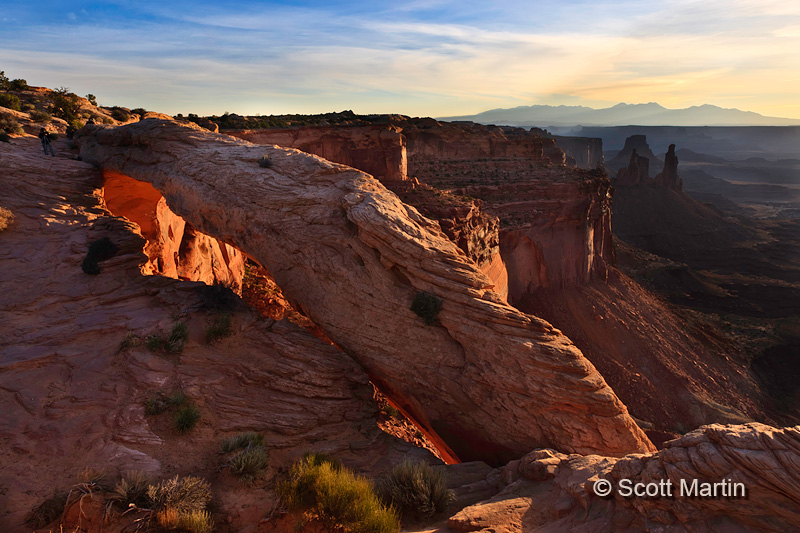
Finally some close-ups. The Mesa Arch is one of the most photographed arches on the planet so there are no unique or original shots to be taken, that said, you always try to take something that is a little bit different.
It seems that many of the rock formations have their own descriptive names. In the right central portion of the image below you can see three local landmarks. The ‘Washer Woman Arch’ is in silhouette in front of ‘Airport Tower’ and immediately left of ‘Monster Tower’.
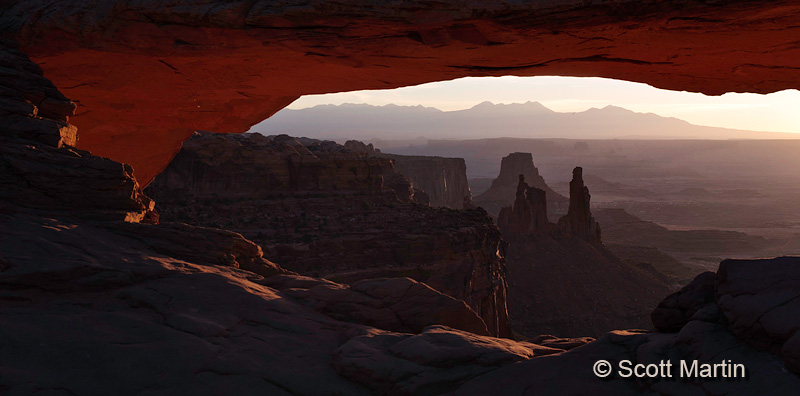
.
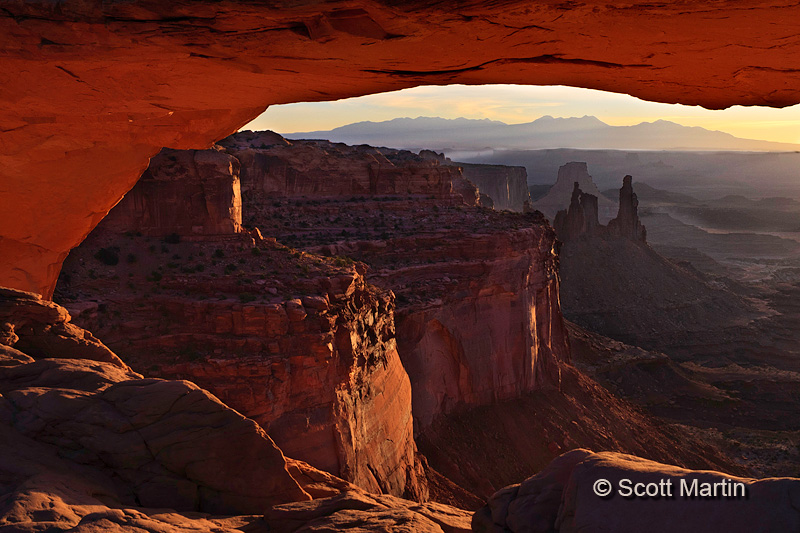
.
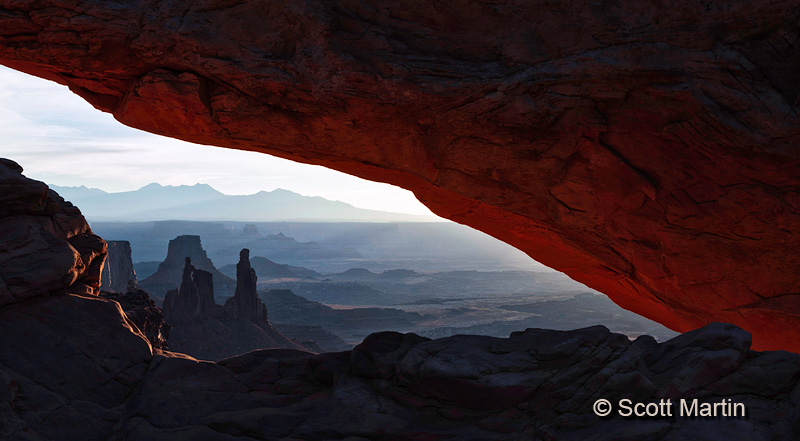
.

I trust these images have inspired you to plan a trip to Canyonlands National Park to experience a sunrise at the Mesa Arch.
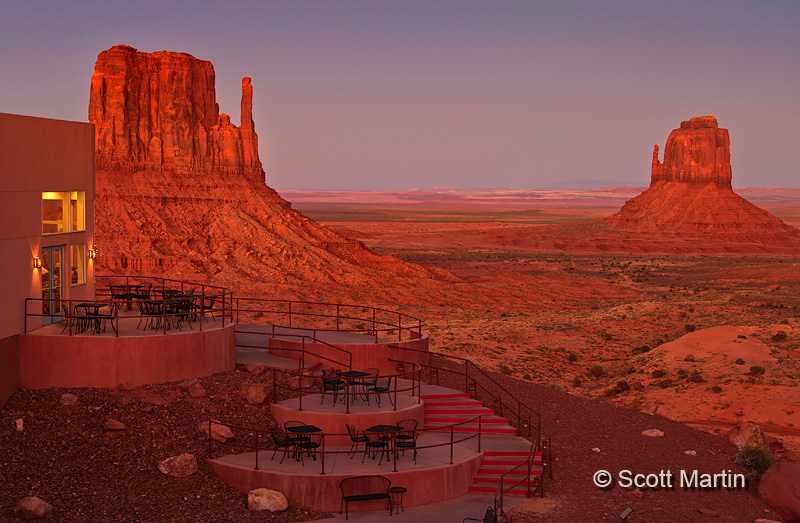
by Scott Martin Photography | Feb 24, 2012 | Blog, Landscapes, Naturescapes, Travel
Monument Valley is a vast area within the Colorado Plateau which is characterized by huge sandstone buttes and mittens, the largest of which are over one thousand feet high. Monument Valley is part of the Navajo lands and all of the images in this post were taken within the 92,000 acre Monument Valley Navajo Tribal Park. Monument Valley is entered off Hwy 163 just south of the Utah, Arizona border and a few miles west of the Four Corners. For the trivia buffs, the Four Corners is the only place in America where the borders of four states meet….Arizona, Utah, Colorado and New Mexico.
While in Monument Valley, Deb & I stayed in the The View Hotel which was a terrific spot and every room has a view like no other hotel you have ever stayed at. When in the area, this is the only place to stay if you want to capture incredible sunrises and sunsets without leaving your room. Here is a twilight image of the West and East Mittens (and hotel dining room entrance) taken from our balcony.

.
Monument Valley is a wonderful place to photograph; the awe-inspiring beauty of the landscape, the sheer size of the buttes & mittens and the dynamic light creates ever-changing colour hues within both rock and sky so each image is different from the other even though the object remains the same. The following images are an attempt to show case the three sandstone formations that comprise the famous Monument Valley Panorama; the West Mitten, East Mitten and Merrick Butte.
The first five images are sunsets.
The Mitten Buttes (West & East)
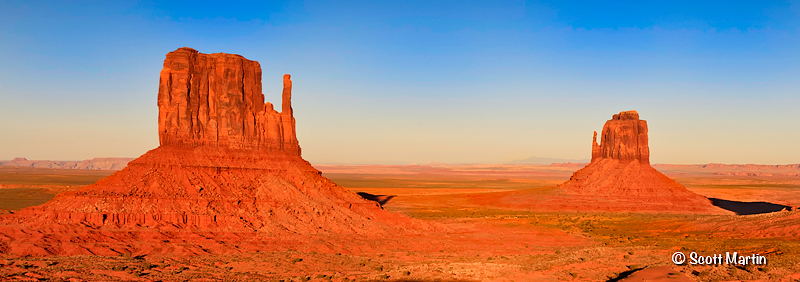
The West Mitten
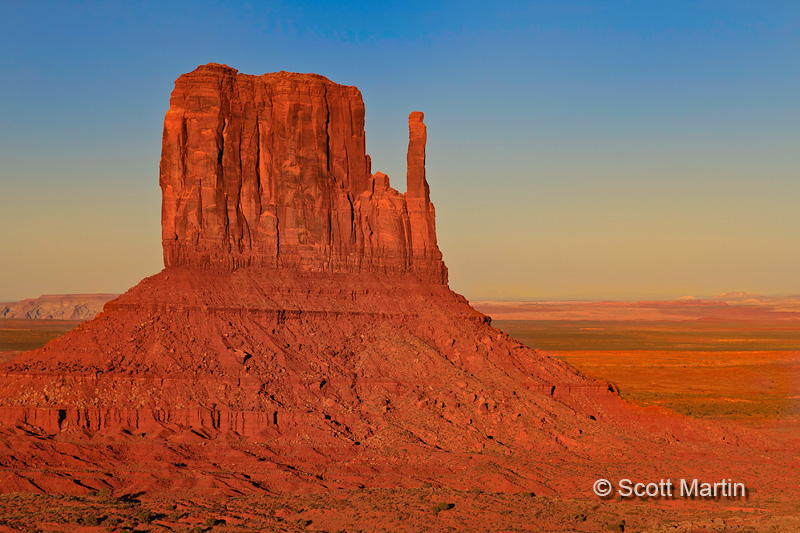
The East Mitten
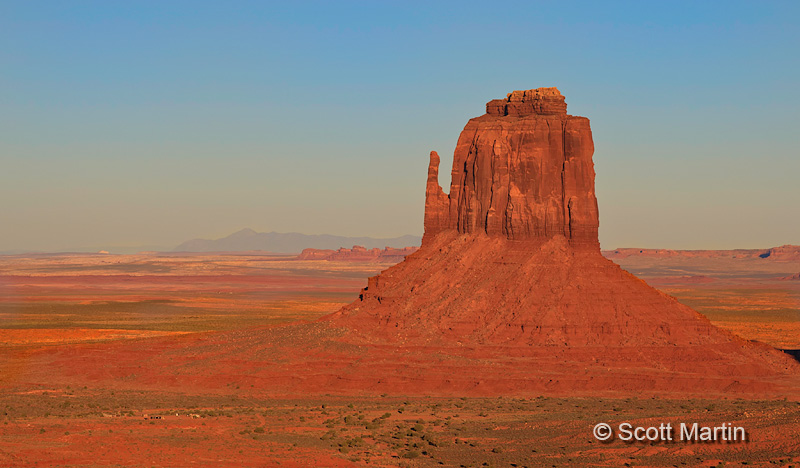
The East Mitten and Merrick Butte
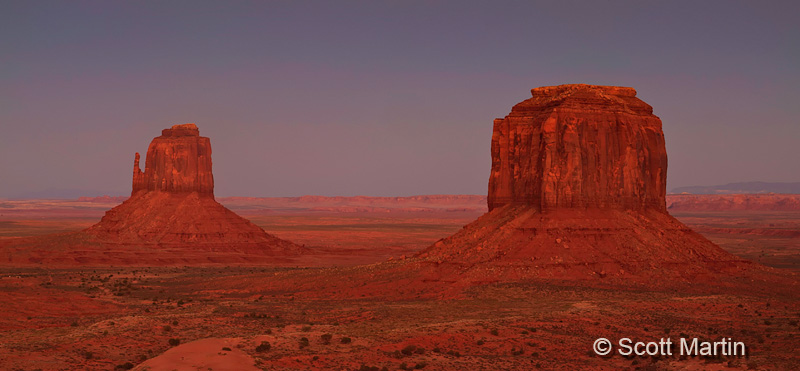
The same shot, different time, different sky….amazing!
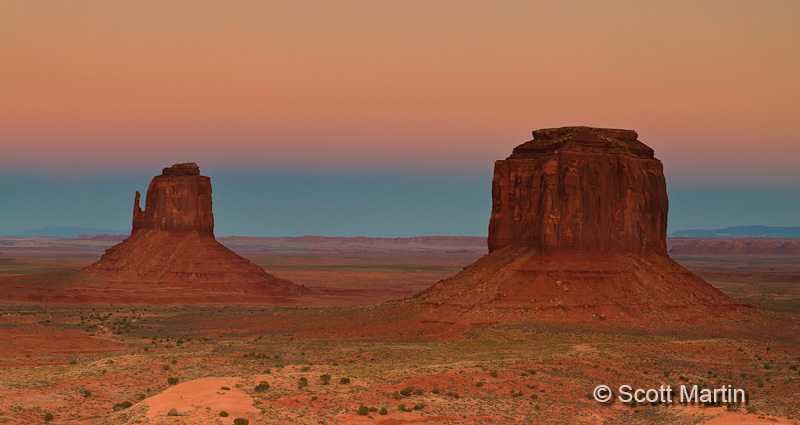
The following images are sunrise shots and as is often the case the photographs taken before sunrise are the ones that catch your eye.
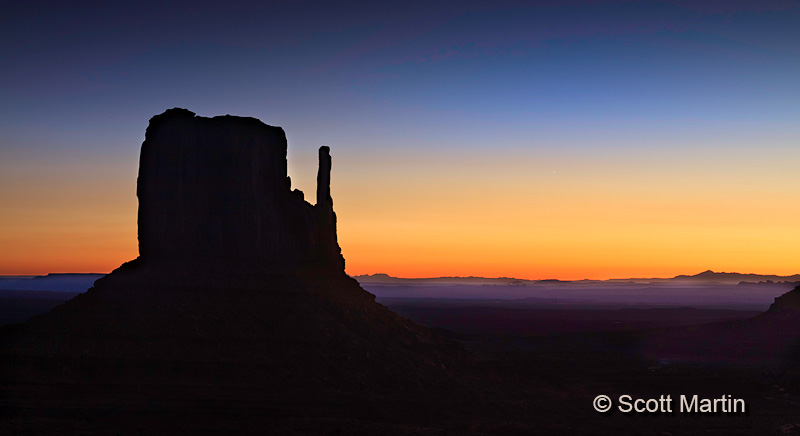
.
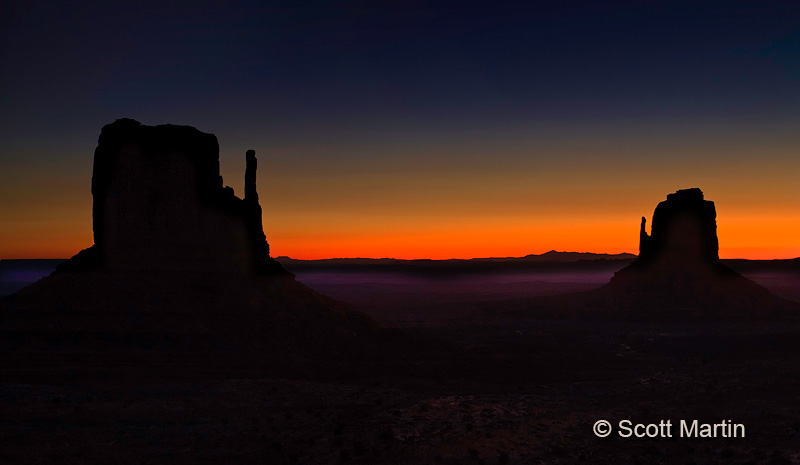
.
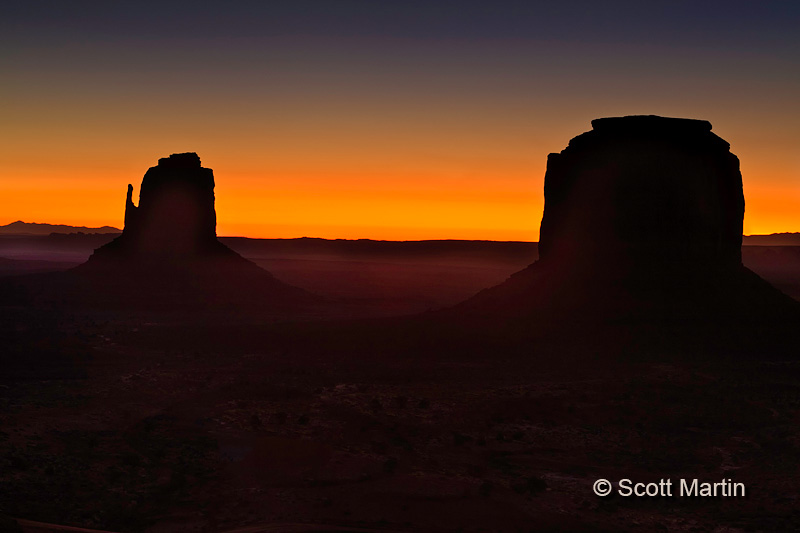
.
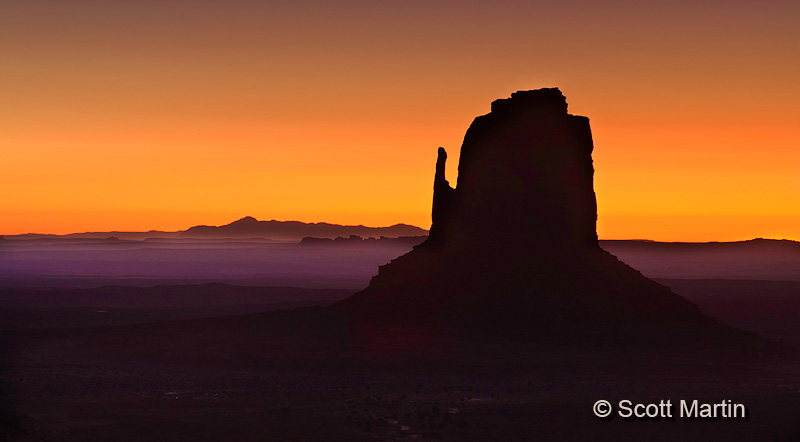
.
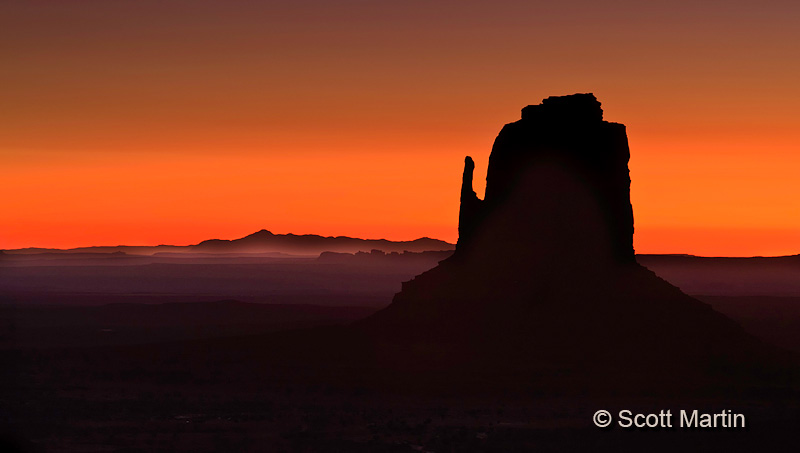
.
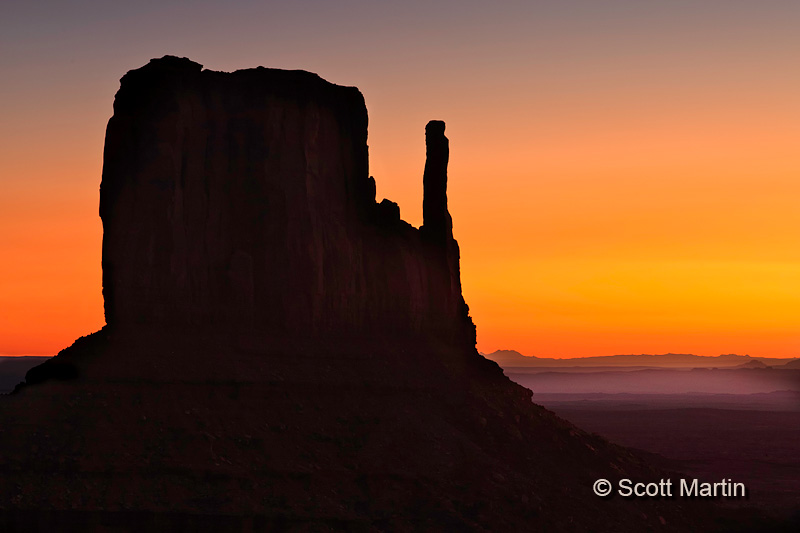
.
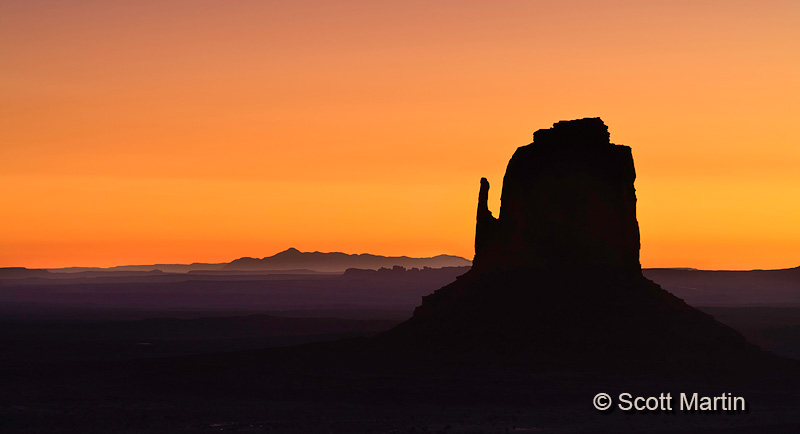
.
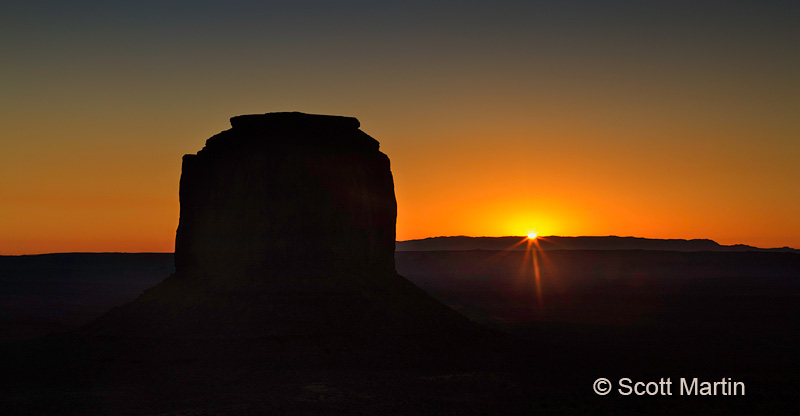
.
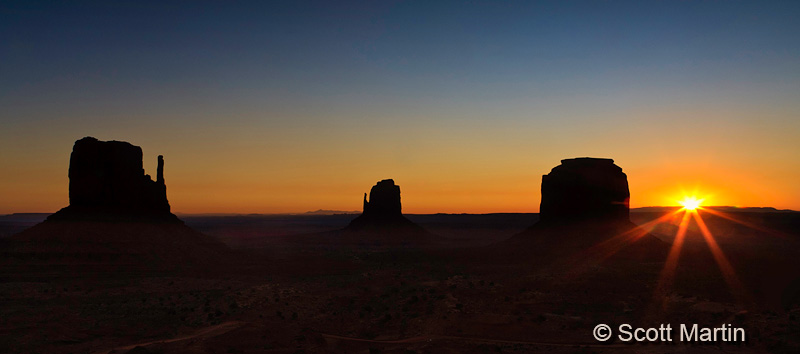
If memory serves me correctly these images were taken using three different lenses; 16-35/2.8; 24-105/4 and 70-200/2.8 Most of this series was also taken using 4×6 Lee ND Grad filters.
After watching the sunrise we headed out into the valley where there is a forty mile dirt road that winds its way around countless buttes, each one a great photographic opportunity, the result of which I’ll post another time. From Monument Valley we headed North along Highway 163 to Moab Utah and two more incredible National Parks; Canyonlands and Arches.
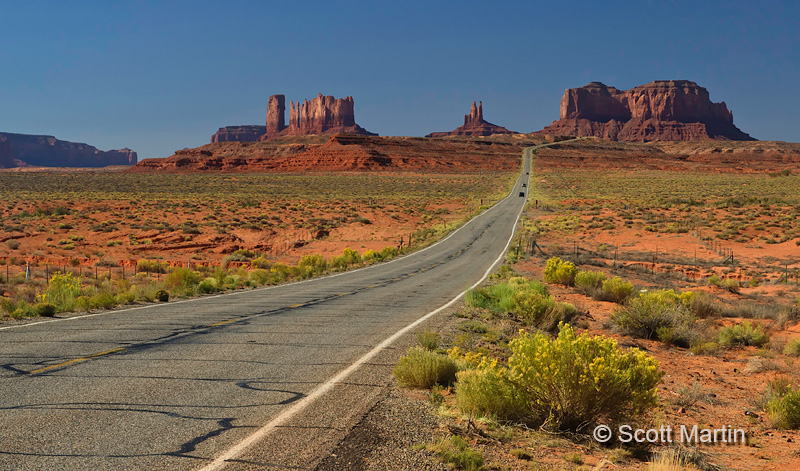
by Scott Martin Photography | Feb 17, 2012 | Blog, Landscapes, Naturescapes, Travel
Heading southwest towards Monument Valley on Route 163 near the Utah Arizona border you are greeted by one of the most iconic open road views in the country. Our first glimpse of this amazing vista was in the rear view mirror as we were heading North towards Moab at the time! No doubt you have seen pictures similar to the ones posted today, however I trust you also enjoy these. Please feel free to comment on them and let me know which perspectives you enjoy the best.
The five images to follow were all taken hand-held at focal lengths ranging from 16-105 mm, with the perception of the depth of the image being progressively compressed at the focal length increases. One of the ‘rules’ of wide-angle landscape photography is to have something of interest in both the foreground and background , however this creates a problem for shots like these where the topography is pretty nondescript save for the incredible buttes and mittens that are at least five miles away. To try to follow the rules of composition, I found the largest bush along the road side and positioned it in the foreground of the image, making sure to have the camera high enough that separation was maintained between the bush and the background rock formation.

This next shot was taken from the same general spot as the first image (you can see the bush used as foreground object in the last shot on the right side of this image as well). The only differences being focal length (24mm) and lower camera height to change the perspective making the road more prominant. For this shot I was lying down so the camera was only about six inches above the road. This image is a single frame, cropped to create the panoramic look.

The last three images attempt to find a pleasing balance of perspective and composition resulting in a great photograph, or moving the image from a snapshot to a photograph.
The next image is just a snapshot, taken with the camera at standing height from relatively close to the rock formation. Being too close to the background stops the road from disappearing into a long thin ribbon which takes a way the feeling of great distances and also reduces the ability to sense just how big the rock formations actually are. Both of these problems are compounded by the longer focal length chosen to take the image (105 mm).
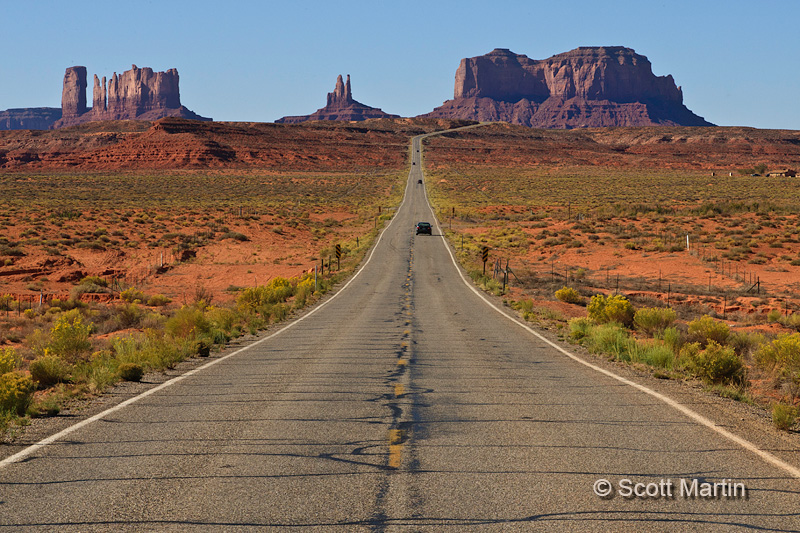
The last two shots come the closest to working well at conveying the feeling of what it was like to actually be there. The next image was taken from the farthest point away from the buttes which were about four or five kilometres away. It was taken standing to reduce the relative size of the road in the foreground and including a bend in the road to change the way your eyes are led towards the buttes and mittens in the background.
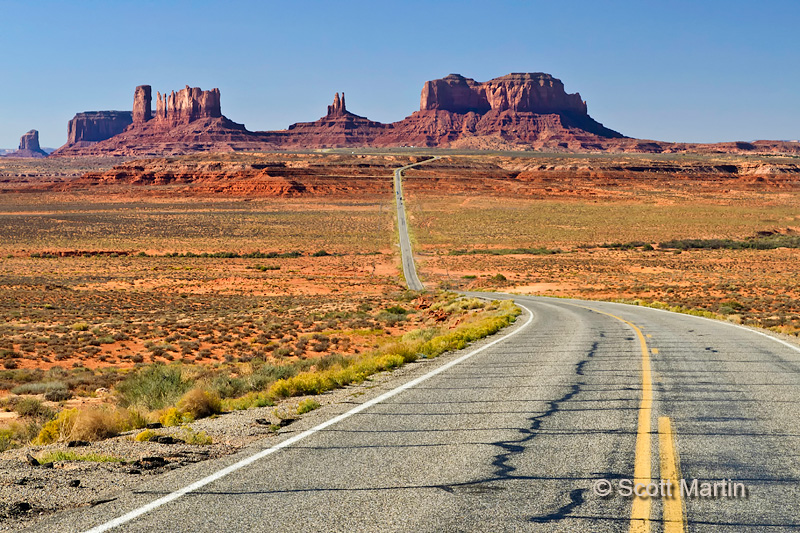
The last image is my favourite of this group. It was taken from a sitting position in the middle of the road to enlarge the presence of the road slightly as well as allowing the small berms on the roadside to provide some foreground interest. Plus the straight road into Monument Valley takes you immediately to the object of the image. The shot was taken at 65mm at f/16 at 1/100 sec.
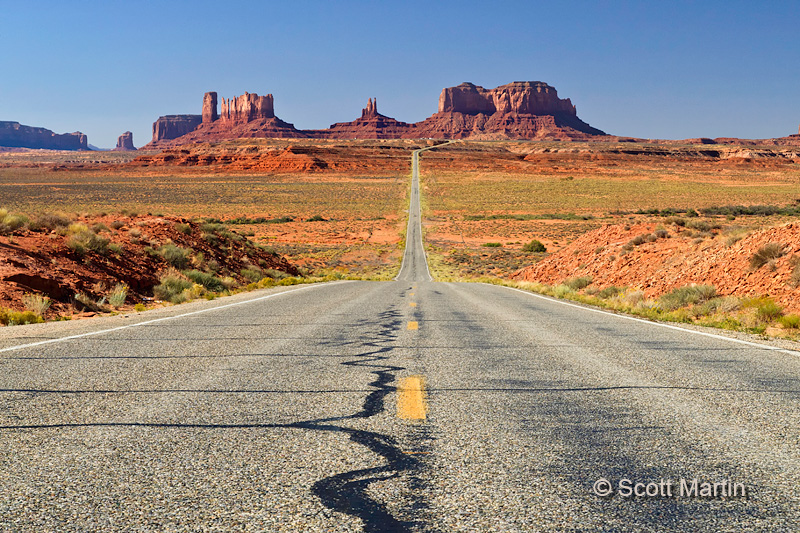
The enjoyment of an image is a purely subjective thing, we either like it, don’t like it or are ambivalent towards it. The trick with good photography is to deliver images that someone other than yourself actually likes! To do that we need to learn to always be thinking about the pictures we are taking, and then experimenting with different variations of the same scene like I’ve tried to demonstrate with these images of Monument Valley. The more thought one puts into the exercise before pressing the shutter really helps deliver consistently better images. It is so much easier to improve your skills in the digital age as CF cards are inexpensive and we can take lots of images in order to arrive at a couple of good ones. For this series Deb & I probably spent an hour or so stopping at four or five different spots along the highway and taking about seventy-five images.
If you haven’t already been there, plan a trip to Monument Valley. You will be glad you did!























































Follow Scott Martin Photography